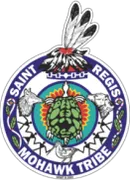EDITOR'S NOTE: On September 12th; Saint Regis Mohawk Tribal Chiefs Eric Thompson and Beverly Cook, along with Sub-Chief Agnes 'Sweets' Jacobs and members of the Tribe's Environment Division provided a first-hand account to EPA Region 2 Administrator Pete Lopez on the impact of industrial pollution and the need to have our people more directly involved in guiding remediation activities. We were pleased to receive and share the following remarks from the EPA Regional Administrator and his support for implementation of a community-based solutions for cleanup efforts; as the Tribe continues to advocate for healthy air, healthy water, and healthy people.
Dear Region 2 Colleagues,
Earlier this month, I traveled to Akwesasne, NY with some of our Region 2 colleagues to meet with the Saint Regis Mohawk Tribe (SRMT), and I wanted to share some of our experiences with you all. Seeing the community first-hand and discussing priorities with the SRMT Tribal Council and Environment Division staff was an opportunity which Chief Eric Thompson accurately described: “sheds light on areas you can’t extrapolate from text.” This kind of meaningful engagement exemplifies the community-driven approach I am championing across the Agency.
We began our visit with a boat tour of the St. Lawrence River, which allowed me to experience the great beauty of Akwesasne and the surrounding area—a perfect backdrop to a discussion of the SRMT’s concerns about the magnitude and impacts to the community of both the Reynolds and GM Landfill Superfund sites, which we viewed from the water. The second day began at the SRMT Housing Authority Training Center, where Chief Thompson led the Mohawk Thanksgiving Address, starting our conversations with an acknowledgment and gratitude for everything in creation. As we discussed specific issues regarding two nearby superfund sites, the GM Landfill and Grasse River sites, we made an effort to take a more holistic approach. SRMT recognized this as a new way of doing business, and we focused the conversation around community revitalization and protecting the community, specifically the cultural uses of the river. This discussion really drove home the importance of good communication, frequent collaboration, and engagement between regulatory agencies and SRMT leadership and environmental staff, highlighting the benefits of exploring new ways of fulfilling EPA’s mission. Jessica Jock, SRMT Program Manager for St. Lawrence Area of Concern, explained to us: “It’s not just about the primary contaminants of concern we are trying to reduce exposure to, it’s how we maintain the cultural revitalization of our community.” This message really resonated with all of us. We had robust discussions, which will not only support our efforts at the Superfund sites near Akwesasne, but also lead to improvements in our regional processes relating to tribal consultation overall.
SRMT rightly made the point that EPA supports communities through multiple layers not just our regulatory authority, again aligning with the principles of our community-driven approach. The rest of our trip was also an eye-opening experience from visiting the Hogansburg Dam and learning about placemaking and resiliency efforts to touring the drinking water treatment plant and discussing the Nation’s treatment as a state under the Clean Water Act. While we still have a lot of work to do, it was clear from our two days meeting with the Nation that we see eye-to-eye on working together with mutual respect as partners to support SRMT’s vision and arrive at community-driven solutions.
We are looking forward to continuing to work with tribal leadership and SRMT staff to address concerns with ongoing EPA projects and unmet needs, most importantly to ensure cultural and natural resources use rights are not impaired. I hope that sharing our visit serves as another source of inspiration to you on the importance of working with communities to address all of their environmental, public health, and quality of life concerns.
Sincerely,
Pete Lopez
EPA Region 2 Administrator

